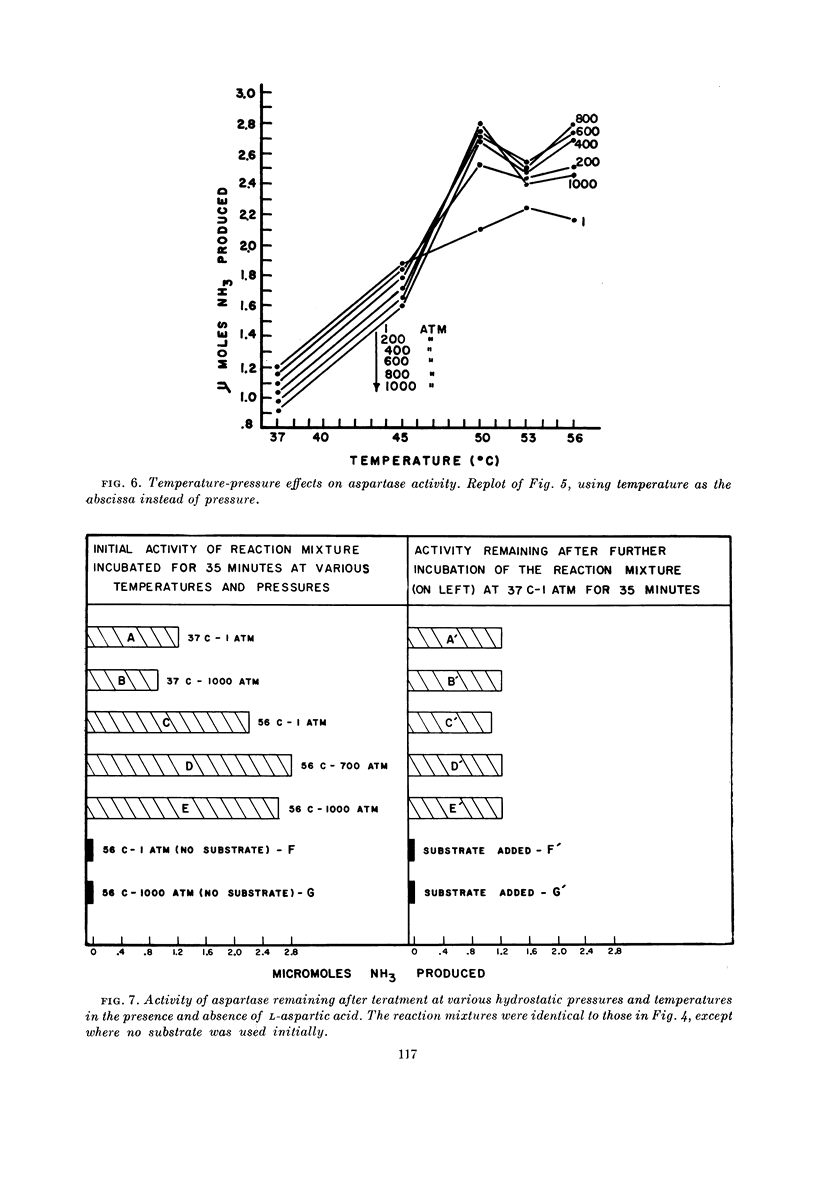Abstract
Haight, Roger D. (University of Nebraska, Lincoln) and Richard Y. Morita. Interaction between the parameters of hydrostatic pressure and temperature on aspartase of Escherichia coli. J. Bacteriol. 83:112–120. 1962.—The data obtained from studies of an aspartase preparation and aspartase in cells of Escherichia coli indicate that there is an interaction between the parameters of hydrostatic pressure and temperature. Pressure was found to decrease aspartase activity at 45 C and lower in vitro and below 53 C in vivo, thereby indicating that when the enzyme-substrate complex is formed there is an increase in molecular volume which is counteracted by pressure. Above 53 C in vivo and above 45 C in vitro, temperature probably starts the unfolding process of the enzyme to expose more reactive sites, while pressure then pushes the enzyme and substrate into closer proximity with each other. Thus, pressure stimulated activity and also prevents further unfolding of the enzyme. Since the enzyme preparation retains about the same level of activity after being subjected first to 1000 atm at 56 C, the aspartase probably refolds into its original configuration or one similar to it, when subjected to 1 atm at 37 C.
In all cases, the presence of the substrate was found necessary to protect aspartase from thermal inactivation or denaturation.
Full text
PDF








Selected References
These references are in PubMed. This may not be the complete list of references from this article.
- BERGER L. R. Some effects of pressure on a phenylglycosidase. Biochim Biophys Acta. 1958 Dec;30(3):522–528. doi: 10.1016/0006-3002(58)90098-2. [DOI] [PubMed] [Google Scholar]
- Doty P., Marmur J., Eigner J., Schildkraut C. STRAND SEPARATION AND SPECIFIC RECOMBINATION IN DEOXYRIBONUCLEIC ACIDS: PHYSICAL CHEMICAL STUDIES. Proc Natl Acad Sci U S A. 1960 Apr;46(4):461–476. doi: 10.1073/pnas.46.4.461. [DOI] [PMC free article] [PubMed] [Google Scholar]
- MORITA R. Y., ZOBELL C. E. Effect of hydrostatic pressure on the succinic dehydrogenase system in Escherichia coli. J Bacteriol. 1956 Jun;71(6):668–672. doi: 10.1128/jb.71.6.668-672.1956. [DOI] [PMC free article] [PubMed] [Google Scholar]
- Pauling L., Campbell D. H. THE PRODUCTION OF ANTIBODIES IN VITRO. Science. 1942 Apr 24;95(2469):440–441. doi: 10.1126/science.95.2469.440. [DOI] [PubMed] [Google Scholar]
- ZOBELL C. E., OPPENHEIMER C. H. Some effects of hydrostatic pressure on the multiplication and morphology of marine bacteria. J Bacteriol. 1950 Dec;60(6):771–781. doi: 10.1128/jb.60.6.771-781.1950. [DOI] [PMC free article] [PubMed] [Google Scholar]


